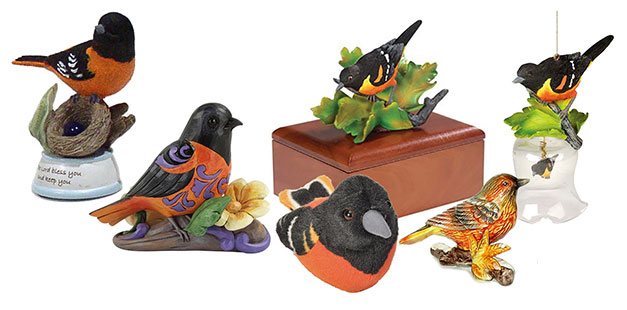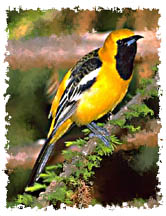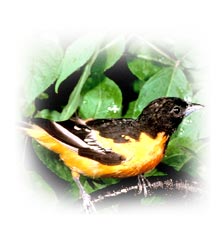


Orioles are colorful tree-dwelling birds,  quite different in habits, appearance, habitat preference, and nest structure from their ground-feeding relatives. All North American orioles have the same basic pattern. Adult males and most first-year males are strikingly marked with brilliant breasts, bellies, and rump patches that contrast with black wings, black throats or heads, and in many species black rounded tails. Most females are similar to one another and pose a real problem in the Southwest, where several species occur. All have conspicuous wingbars and very sharply pointed beaks.
quite different in habits, appearance, habitat preference, and nest structure from their ground-feeding relatives. All North American orioles have the same basic pattern. Adult males and most first-year males are strikingly marked with brilliant breasts, bellies, and rump patches that contrast with black wings, black throats or heads, and in many species black rounded tails. Most females are similar to one another and pose a real problem in the Southwest, where several species occur. All have conspicuous wingbars and very sharply pointed beaks.
Orioles migrate primarily by night, but loose bands of 5-10 may sometimes be seen  just above the treetops in the early morning.
just above the treetops in the early morning.
The nest is made from grasses, plant fibers, hair, strings, etc. and firmly interwoven and hung from the end of branches in shade or fruit trees at heights of from 10 to 90 feet. Eggs are four to six white with irregular streaks and blotches of brown and black. Orioles feed on caterpillars, beetles and other insects; wild and some cultivated fruits.
The Hooded Oriole (Icterus cucullatus), pictured at top, is from 7-7-3/4 inches long. This is the only common U.S. oriole with an orange crown. The bill is long and slightly curved. The song is a series of whistles, chatters and warbles. This species breeds from central California, southern Nevada, southwest Utah, central Arizona, southwest New Mexico, western and southern Texas (near the Rio Grande) to southern Mexico. A few winter in southern California and southern Texas. Its habitat is open woodlands, thickets, palms, and shade trees. The Baltimore Oriole is pictured above at right.
You can find the Jim Shore Oriole, Wild Republic Oriole, Oriole figurine, Oriole Bell and more at our sponsor's website: www.jeanniescottage.com.



